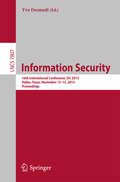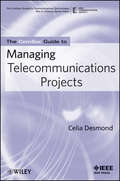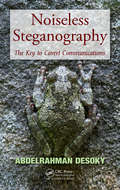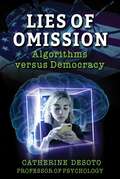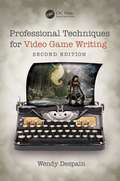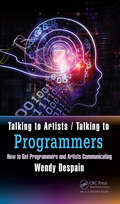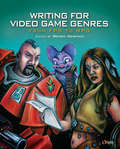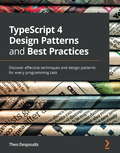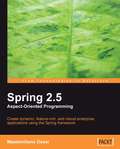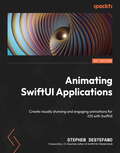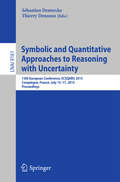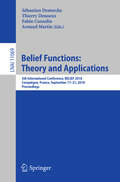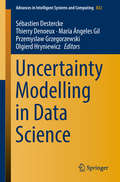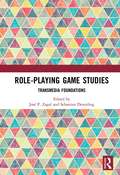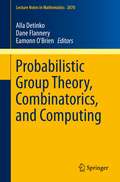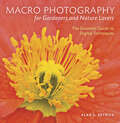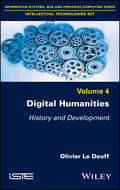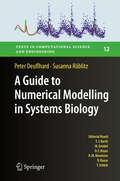- Table View
- List View
Information Security
by Yvo DesmedtThis book constitutes the thoroughly refereedpost-conference proceedings of the 16th International Conference on InformationSecurity, ISC 2013, held in Dallas, Texas, in November 2013. The 16 revised full papers presented together with 14short papers were carefully reviewed and selected from 70 submissions. Thepapers cover a wide range of topics in the area of cryptography andcryptanalysis and are organized in the following topical sections: security ofoperating systems; secret sharing; encryption; malware and Criticalinfrastructures; cryptanalysis; block ciphers and stream ciphers; entityauthentication; usability & risk perception; access control; computersecurity; privacy attacks; cryptography.
The Psychology of Totalitarianism
by Mattias DesmetThe world is in the grips of mass formation—a dangerous, collective type of hypnosis—as we bear witness to loneliness, free-floating anxiety, and fear giving way to censorship, loss of privacy, and surrendered freedoms. It is all spurred by a singular, focused crisis narrative that forbids dissident views and relies on destructive groupthink. Desmet’s work on mass formation theory was brought to the world’s attention on The Joe Rogan Experience and in major alternative news outlets around the globe. Read this book to get beyond the sound bites! Totalitarianism is not a coincidence and does not form in a vacuum. It arises from a collective psychosis that has followed a predictable script throughout history, its formation gaining strength and speed with each generation—from the Jacobins to the Nazis and Stalinists—as technology advances. Governments, mass media, and other mechanized forces use fear, loneliness, and isolation to demoralize populations and exert control, persuading large groups of people to act against their own interests, always with destructive results. In The Psychology of Totalitarianism, world-renowned Professor of Clinical Psychology Mattias Desmet deconstructs the societal conditions that allow this collective psychosis to take hold. By looking at our current situation and identifying the phenomenon of “mass formation”—a type of collective hypnosis—he clearly illustrates how close we are to surrendering to totalitarian regimes. With detailed analyses, examples, and results from years of research, Desmet lays out the steps that lead toward mass formation, including: An overall sense of loneliness and lack of social connections and bonds A lack of meaning—unsatisfying “bullsh*t jobs” that don’t offer purpose Free-floating anxiety and discontent that arise from loneliness and lack of meaning Manifestation of frustration and aggression from anxiety Emergence of a consistent narrative from government officials, mass media, etc., that exploits and channels frustration and anxiety In addition to clear psychological analysis—and building on Hannah Arendt’s essential work on totalitarianism, The Origins of Totalitarianism—Desmet offers a sharp critique of the cultural “groupthink” that existed prior to the pandemic and advanced during the COVID crisis. He cautions against the dangers of our current societal landscape, media consumption, and reliance on manipulative technologies and then offers simple solutions—both individual and collective—to prevent the willing sacrifice of our freedoms. “We can honor the right to freedom of expression and the right to self-determination without feeling threatened by each other,” Desmet writes. “But there is a point where we must stop losing ourselves in the crowd to experience meaning and connection. That is the point where the winter of totalitarianism gives way to a spring of life.” “Desmet has an . . . important take on everything that’s happening in the world right now.”—Aubrey Marcus, podcast host “[Desmet] is waking a lot of people up to the dangerous place we are now with a brilliant distillation of how we ended up here.”—Robert F. Kennedy, Jr.
Configuring SonicWALL Firewalls
by Simon Desmeules Barry J. StiefelConfiguring SonicWALL Firewal is the first book to deliver an indepth look at the SonicWALL firewall product line. It covers all of the aspects of the SonicWALL product line from the SOHO devices to the Enterprise SonicWALL firewalls. Also covered are advanced troubleshooting techniques and the SonicWALL Security Manager. This book offers novice users a complete opportunity to learn the SonicWALL firewall appliance. Advanced users will find it a rich technical resource.
The ComSoc Guide to Managing Telecommunications Projects (The ComSoc Guides to Communications Technologies #7)
by Celia DesmondThis pocket guide provides an overview of the telecommunications environment as it has evolved over the past few years, illustrating the need for project management, the significance of project success to the companies, and the application of key project management processes within the telecom environment. Topics covered include: scope management, time management, cost management, procurement management, risk management, communications, quality, human resources, and Integration. It offers professionals a brief and accessible guide to managing telecommunication projects in the 21st century.
Simplifying State Management in React Native: Master state management from hooks and context through to Redux, MobX, XState, Jotai and React Query
by Aleksandra Desmurs-LinczewskaMake fact-based decisions by comparing different solutions and learning popular ways to manage state in React Native with clear guidelines and recommendations by a React Native expertKey FeaturesExplore the big picture of state management in React Native using the most simplified versionImplement state management solutions by building a social media clone appCompare different state solutions in a contained environment to choose the best fit for your future projectsBook DescriptionManaging state in a React Native app can be challenging as it is one of the most difficult concepts to grasp while learning React Native. This is because there are so many ways to do it, and because there is a lack of clear guidelines on what should be used and why.Simplifying State Management in React Native is a comprehensive introduction for those who are new to creating robust React Native apps that will have you up to speed in no time. You'll get to grips with the different state management strategies and libraries available. As you progress through the chapters, you'll try out different solutions, as well as compare and choose which solution is perfectly suited to your future projects and personal preferences. Finally, you'll create a social media clone app using all the concepts and examples that you've learned in this book.By the end of this book, you'll be able to take on existing projects that use various state management strategies and libraries, and confidently make decisions about state management.What you will learnStart out by going over the basic ReactJS “mindset”Explore all that ReactJS has to offer to manage state in apps by building an appUnderstand existing state management libraries such as Redux, MobX, XState, Jotai, and React QueryDecide which libraries you want to use in your appsDesign a social media app to fully understand state managementTry out all the solutions presented in the book in a social media clone appWho this book is forThis book is for junior developers, React Native developers, and mobile app developers who are already using React Native, but are also on the lookout for advice and for a broader view to manage the state and changes in their applications. Basic knowledge of ReactJS and React Native, as well as familiarity with JavaScript and general mobile app development concepts are needed to grasp the topics covered in this book.
Design and Architecture for Signal and Image Processing: 15th International Workshop, DASIP 2022, Budapest, Hungary, June 20–22, 2022, Proceedings (Lecture Notes in Computer Science #13425)
by Karol Desnos Sergio PertuzThis book constitutes the thoroughly refereed conference proceedings of the First International Workshop on Design and Architecture for Signal and Image Processing, DASIP 2022, held in Budaypest, Hungary in June 2022. The 13 full included in the volume were carefully reviewed and selected from 32 submissions. They are organized in the following topical sections: leading signal, image and video processing and machine learning in custom embedded, edge and cloud computing architectures and systems.
Noiseless Steganography: The Key to Covert Communications
by Abdelrahman DesokyAmong the features that make Noiseless Steganography: The Key to Covert Communications a first of its kind: The first to comprehensively cover Linguistic SteganographyThe first to comprehensively cover Graph SteganographyThe first to comprehensively cover Game SteganographyAlthough the goal of steganography is to prevent adversaries from suspe
Lies of Omission: Algorithms versus Democracy
by Catherine DeSotoA lie of omission—withholding needed information to correct a false belief. There is a sharp and more hostile divide emerging in the United States. The shift is documented by various polls, and the speed of the change is alarming. There are certainly contributing factors, but one factor is unique to the contemporary era: receiving the majority of our information via social media experiences. Media algorithms, and to some extent overt censorship, serve users curated content that is unlike what their neighbors receive.Lies of Omission brings together various perspectives on the causes and effects of the divided information streams. Psychology and neuroscience, combined with some historical jurisprudence, are woven together to spell out the dangers of the modern social media experience. Importantly, the human response can be understood as rooted in our psychology and neurochemistry. In part two of the book, eight hot button issues that have provoked deep divisions among American citizens are presented as well-researched, opposing-view chapters with a goal to lay bare the extent of the disinformation gap that we are living in. With the rise of ephemeral smart media, and the associated displacement of the permanently printed word, it is rare to have a clear idea of what persons who do not share our opinions actually believe, or why.The decimation of communal information sources is nearly complete. What can one do? One concrete step is to turn some of your attention away from curated, impermanent news and read a book. Read this book. Dr. Catherine DeSoto spells out why it is worth our time to be informed regarding the issues we care about: something your phone&’s curated media will never do for you. Open your mind to the quaint idea that one is not informed unless one understands the opposing view. Surprising all-new research regarding the political divide and the pandemic is included. Together with over 150 references, this book will be the definitive source documenting the effects of the media algorithm revolution.
Professional Techniques for Video Game Writing
by Wendy DespainThis second edition of Professional Techniques for Video Game Writing is updated with new chapters and new authors, but it’s still a no-nonsense guide to the professional craft of writing for video games. Not only does the text cover story and narrative elements, but it also addresses dialogue, documentation, and strategy guides. Seasoned video game writers each address a different topic, including the best way to break into the video game industry, how to be an efficient part of a team, and the principles of narrative design. The book also offers script samples, technical writing advice, effective writing tips, and suggestions for how to innovate in game narrative. Key Features Comprehensive enough for veterans and accessible enough for novices Goes into detail about how to write tutorials, script doctoring, and writing for AAA games Delivers invaluable experiences directly from writers in the games industry Full of practical advice from industry pros on how to get a job, and then how to get the job done Author Bio Wendy Despain has more than two decades of experience spearheading digital media projects. She has worked with teams around the world as a writer, narrative designer, producer, and consultant on interactive experiences ranging from video games to augmented reality. She’s worked with EA, Disney, Ubisoft, Cartoon Network, PBS, Marvel, and Wargaming. Currently, she’s a Production Director at ArenaNet, makers of the Guild Wars franchise. Her books include: Writing For Videogame Genres: From FPS to RPG Talking to Artists/Talking to Programmers 100 Principles of Game Design
Talking to Artists / Talking to Programmers: How to Get Programmers and Artists Communicating
by Wendy DespainArtists and programmers often work together on complex projects in stressful environments and things don’t always go smoothly. Miscommunication and misunderstandings are common as these two disciplines often use the same words to mean different things when they talk to each other. Unintentional slights can turn into long-held grudges and productivity grinds to a crawl. This is a "flip book" that contains two narratives in one. Turn the book one way and read one perspective; turn the book over and upside down and read the other perspective. The narratives can be read separately, one after the other, or in alternating chapters. Talking to Artists / Talking to Programmers can help anyone who wants to improve communication with artists and programmers. It’s set up like a foreign language dictionary, so it addresses the cultural norms, attitudes and customs surrounding the words each group uses, so you’ll know not just what the words in the glossary mean, you’ll know why they’re used that way and how to get communication flowing again. It addresses common reasons for communication problems between these two groups and provides specific suggestions for solutions. The unusual format allows for each side to be given equal weight - learn how to talk to artists starting on one side of the book, turn it over and learn how to talk to programmers. The whole book stresses the things artists and programmers have in common. Focused primarily on videogame developers, it also applies to other fields where tech and art have to work together, including web developers and teams building mobile apps. Anyone who wants to communicate better with programmers or artists - this book can help Features Lists of common problems and strategies for solving them Specific ideas for building bridges between departments Case studies from real teams Glossary of terms causing the most confusion Explanations for common friction points Approaches for fostering goodwill Solutions for team dynamics problems Specific suggestions for providing feedback Ideas for holding successful meetings
Writing for Video Game Genres: From FPS to RPG
by Wendy DespainThis book, written and edited by members of the International Game Developers Association (IGDA) Game Writing Special Interest Group, follows the acclaimed Professional Techniques for Video Game Writing to deliver practical advice from seasoned veterans on the special challenges of writing for first-person shooter games (FPS), role-playing games (R
Thermal Stability of Metastable Magnetic Skyrmions (Springer Theses)
by Louise DesplatThe energy cost associated with modern information technologies has been increasing exponentially over time, stimulating the search for alternative information storage and processing devices. Magnetic skyrmions are solitonic nanometer-scale quasiparticles whose unique topological properties can be thought of as that of a Mobius strip. Skyrmions are envisioned as information carriers in novel information processing and storage devices with low power consumption and high information density. As such, they could contribute to solving the energy challenge.In order to be used in applications, isolated skyrmions must be thermally stable at the scale of years. In this work, their stability is studied through two main approaches: the Kramers' method in the form of Langer's theory, and the forward flux sampling method. Good agreement is found between the two methods. We find that small skyrmions possess low internal energy barriers, but are stabilized by a large activation entropy. This is a direct consequence of the existence of stable modes of deformation of the skyrmion. Additionally, frustrated exchange that arises at some transition metal interfaces leads to new collapse paths in the form of the partial nucleation of the corresponding antiparticle, as merons and antimerons.
TypeScript 4 Design Patterns and Best Practices: Discover effective techniques and design patterns for every programming task
by Theo DespoudisA detailed and easy-to-follow guide to learning design patterns and modern best practices for improving your TypeScript development skillsKey FeaturesUnderstand, analyze, and develop classical design patterns in TypeScriptExplore advanced design patterns taken from functional programming and reactive programmingDiscover useful techniques and gotchas when developing large-scale TypeScript applicationsBook DescriptionTypeScript is a superset language on top of JavaScript that introduces type safety and enhanced developer tooling. TypeScript 4 Design Patterns and Best Practices will assist with understanding design patterns and learning best practices for producing scalable TypeScript applications. It will also serve as handy documentation for future maintainers.This book takes a hands-on approach to helping you get up and running with the implementation of TypeScript design patterns and associated methodologies for writing testable code. You'll start by exploring the practical aspects of TypeScript 4 and its new features. The book will then take you through traditional gang of four (GOF) design patterns, such as behavioral, creational, and structural in their classic and alternative forms, and show you how you can use them in real-world development projects. Once you've got to grips with traditional design patterns, you'll advance to learning about their functional programming and reactive programming counterparts and how they can be coupled to deliver better and more idiomatic TypeScript code.By the end of this TypeScript book, you'll be able to efficiently recognize when and how to use the right design patterns in any practical use case and gain the confidence to work on scalable and maintainable TypeScript projects of any size.What you will learnUnderstand the role of design patterns and their significanceExplore all significant design patterns within the context of TypeScriptFind out how design patterns differ from design conceptsUnderstand how to put the principles of design patterns into practiceDiscover additional patterns that stem from functional and reactive programmingRecognize common gotchas and antipatterns when developing TypeScript applications and understand how to avoid themWho this book is forIf you're a developer looking to learn how to apply established design patterns to solve common programming problems instead of reinventing solutions, you'll find this book useful. You're not expected to have prior knowledge of design patterns. Basic TypeScript knowledge is all you need to get started with this book.
Spring 2.5 Aspect Oriented Programming
by Massimiliano DessìEmploying a comprehensive tutorial-based approach, this easy-to-follow book shows the reader various means of using AOP with Spring in a real-world scenario. Clear step-by-step instructions ensure that you will not get lost in the new world of AOP and Spring. If you are a Java software architect, engineer, or developer and want to be able to write applications in a more modular and concise way by using Spring, then you need this book. Readers need basic knowledge of Spring and its configuration.
Animating SwiftUI Applications: Create visually stunning and engaging animations for iOS with SwiftUI
by Stephen DeStefano J.D. GauchatUnleash the power of SwiftUI by building dynamic, cross-platform projects that will amaze their usersPurchase of the print or Kindle book includes a free PDF eBookKey FeaturesExplore the basics of declarative programming and animationUnderstand the fundamentals of SwiftUI and animatable propertiesLearn while working on beginner-to-advanced level animation projectsBook DescriptionSwift and SwiftUI are the backbone of Apple application development, making them a crucial skill set to learn. Animating SwiftUI Applications focuses on the creation of stunning animations, making you proficient in this declarative language and employing a minimal code approach.In this book, you'll start by exploring the fundamentals of SwiftUI and animation, before jumping into various projects that will cement these skills in practice. You will explore some simple projects, like animating circles, creating color spectrums with hueRotation, animating individual parts of an image, as well as combining multiple views together to produce dynamic creations. The book will then transition into more advanced animation projects that employ the GeometryReader, which helps align your animations across different devices, as well as creating word and color games. Finally, you will learn how to integrate the SpriteKit framework into our SwiftUI code to create scenes with wind, fire, rain, and or snow scene, along with adding physics, gravity, collisions, and particle emitters to your animations.By the end of this book, you'll have created a number of different animation projects, and will have gained a deep understanding of SwiftUI that can be used for your own creations.What you will learnUnderstand the fundamentals of SwiftUI and declarative programmingMaster animation concepts like state variables and time curvesExplore animation properties like hueRotation, opacity, and scaleCreate animations using physics, gravity, collision, and moreUse the GeometryReader to align views across various platformsCombine different animations for more dynamic effectsAdd audio to your animations for an interactive experienceWho this book is forThis book is for aspiring SwiftUI developers who have a basic understanding of Swift. It can also be used by SwiftUI developers, UIKit developers, and iOS developers that are new to SwiftUI and want to improve their animation proficiency.
Symbolic and Quantitative Approaches to Reasoning with Uncertainty
by Sébastien Destercke Thierry DenoeuxThis book constitutes the refereed proceedings of the 13th European Conference on Symbolic and Quantitative Approaches to Reasoning with Uncertainty, ECSQARU 2015, held in Compiègne, France, in July 2015. The 49 revised full papers presented were carefully reviewed and selected from 69 submissions and cover topics on decision theory and preferences; argumentation; conditionals; game theory; belief update; classification; inconsistency; graphical models; Bayesian networks; belief functions; logic; and probabilistic graphical models for scalable data analytics. Papers come from researchers interested in advancing the technology and from practitioners using uncertainty techniques in real-world applications. The scope of the ECSQARU conferences encompasses fundamental issues, representation, inference, learning, and decision making in qualitative and numeric uncertainty paradigms.
Belief Functions: 5th International Conference, BELIEF 2018, Compiègne, France, September 17-21, 2018, Proceedings (Lecture Notes in Computer Science #11069)
by Sébastien Destercke Thierry Denoeux Fabio Cuzzolin Arnaud MartinThis book constitutes the refereed proceedings of the 5th International Conference on Belief Functions, BELIEF 2018, held in Compiègne, France, in September 2018.The 33 revised regular papers presented in this book were carefully selected and reviewed from 73 submissions. The papers were solicited on theoretical aspects (including for example statistical inference, mathematical foundations, continuous belief functions) as well as on applications in various areas including classification, statistics, data fusion, network analysis and intelligent vehicles.
Uncertainty Modelling in Data Science (Advances in Intelligent Systems and Computing #832)
by Sébastien Destercke Thierry Denoeux María Ángeles Gil Przemyslaw Grzegorzewski Olgierd HryniewiczThis book features 29 peer-reviewed papers presented at the 9th International Conference on Soft Methods in Probability and Statistics (SMPS 2018), which was held in conjunction with the 5th International Conference on Belief Functions (BELIEF 2018) in Compiègne, France on September 17–21, 2018. It includes foundational, methodological and applied contributions on topics as varied as imprecise data handling, linguistic summaries, model coherence, imprecise Markov chains, and robust optimisation. These proceedings were produced using EasyChair.Over recent decades, interest in extensions and alternatives to probability and statistics has increased significantly in diverse areas, including decision-making, data mining and machine learning, and optimisation. This interest stems from the need to enrich existing models, in order to include different facets of uncertainty, like ignorance, vagueness, randomness, conflict or imprecision. Frameworks such as rough sets, fuzzy sets, fuzzy random variables, random sets, belief functions, possibility theory, imprecise probabilities, lower previsions, and desirable gambles all share this goal, but have emerged from different needs.The advances, results and tools presented in this book are important in the ubiquitous and fast-growing fields of data science, machine learning and artificial intelligence. Indeed, an important aspect of some of the learned predictive models is the trust placed in them. Modelling the uncertainty associated with the data and the models carefully and with principled methods is one of the means of increasing this trust, as the model will then be able to distinguish between reliable and less reliable predictions. In addition, extensions such as fuzzy sets can be explicitly designed to provide interpretable predictive models, facilitating user interaction and increasing trust.
Classical and Quantum Information Theory
by Emmanuel DesurvireInformation theory lies at the heart of modern technology, underpinning all communications, networking, and data storage systems. This book sets out, for the first time, a complete overview of both classical and quantum information theory. Throughout, the reader is introduced to key results without becoming lost in mathematical details. Opening chapters present the basic concepts and various applications of Shannon's entropy, moving on to the core features of quantum information and quantum computing. Topics such as coding, compression, error-correction, cryptography and channel capacity are covered from classical and quantum viewpoints. Employing an informal yet scientifically accurate approach, Desurvire provides the reader with the knowledge to understand quantum gates and circuits. Highly illustrated, with numerous practical examples and end-of-chapter exercises, this text is ideal for graduate students and researchers in electrical engineering and computer science, and practitioners in the telecommunications industry. Further resources and instructor-only solutions are available at www. cambridge. org/9780521881715.
Numerical Methods for Mixed Finite Element Problems: Applications to Incompressible Materials and Contact Problems (Lecture Notes in Mathematics #2318)
by Jean Deteix Thierno Diop Michel FortinThis book focuses on iterative solvers and preconditioners for mixed finite element methods. It provides an overview of some of the state-of-the-art solvers for discrete systems with constraints such as those which arise from mixed formulations.Starting by recalling the basic theory of mixed finite element methods, the book goes on to discuss the augmented Lagrangian method and gives a summary of the standard iterative methods, describing their usage for mixed methods. Here, preconditioners are built from an approximate factorisation of the mixed system.A first set of applications is considered for incompressible elasticity problems and flow problems, including non-linear models.An account of the mixed formulation for Dirichlet’s boundary conditions is then given before turning to contact problems, where contact between incompressible bodies leads to problems with two constraints.This book is aimed at graduate students and researchers in the field of numerical methods and scientific computing.
Role-Playing Game Studies: Transmedia Foundations
by Sebastian Deterding José ZagalThis handbook collects, for the first time, the state of research on role-playing games (RPGs) across disciplines, cultures, and media in a single, accessible volume. Collaboratively authored by more than 50 key scholars, it traces the history of RPGs, from wargaming precursors to tabletop RPGs like Dungeons & Dragons to the rise of live action role-play and contemporary computer RPG and massively multiplayer online RPG franchises, like Fallout and World of Warcraft. Individual chapters survey the perspectives, concepts, and findings on RPGs from key disciplines, like performance studies, sociology, psychology, education, economics, game design, literary studies, and more. Other chapters integrate insights from RPG studies around broadly significant topics, like transmedia worldbuilding, immersion, transgressive play, or player–character relations. Each chapter includes definitions of key terms and recommended readings to help fans, students, and scholars new to RPG studies find their way into this new interdisciplinary field.
Probabilistic Group Theory, Combinatorics, and Computing
by Alla Detinko Dane Flannery Eamonn O'BrienProbabilistic Group Theory, Combinatorics and Computing is based on lecture courses held at the Fifth de Brún Workshop in Galway, Ireland in April 2011. Each course discusses computational and algorithmic aspects that have recently emerged at the interface of group theory and combinatorics, with a strong focus on probabilistic methods and results. The courses served as a forum for devising new strategic approaches and for discussing the main open problems to be solved in the further development of each area. The book represents a valuable resource for advanced lecture courses. Researchers at all levels are introduced to the main methods and the state-of-the-art, leading up to the very latest developments. One primary aim of the book's approach and design is to enable postgraduate students to make immediate use of the material presented.
Macro Photography for Gardeners and Nature Lovers: The Essential Guide to Digital Techniques
by Alan L. DetrickGardeners and nature lovers delight in taking pictures—especially close-ups of flowers, butterflies, and insects. And though advances in digital camera technology have made taking, storing, and sharing photos easier than ever, taking top-quality pictures requires familiarity with both digital technology and the general principles of photography. Macro Photography for Gardeners and Nature Lovers provides exactly the information that aspiring photographers—no matter their level of skill—need to take their photos to the next level. Clear and concise chapters cover the basics of macro (close-up) photography, explain the features of current digital single-lens reflex cameras, show the many ways images can be composed, and share tips on digital effects, storage, and manipulation of imagery. Throughout the text, helpful tips, definitions, exercises, and case studies serve to demystify digital photography. Each lesson is supported by examples of the author's stunning photography. Whether taking photos of flowers and insects, compiling a photographic record of your garden, or simply sharing beautiful images with friends and family, everyone can become accomplished photographers of the world's small-scale wonders.
Digital Humanities: History and Development
by Olivier Le DeuffWhere do the digital humanities really come from? Are they really news? What are the theoretical and technical influences that participate in this scientific field that arouses interest and questions? This book tries to show and explain the main theories and methods that have allowed their current constitution. The aim of the book is to propose a new way to understand the history of digital humanities in a broader perspective than the classic history with the project of Robert Busa. The short digital humanities perspective neglects lots of actors and disciplines. The book tries to show the importance of other fields than humanities computing like scientometry, infometry, econometry, mathematical linguistics, geography and documentation.
A Guide to Numerical Modelling in Systems Biology (Texts in Computational Science and Engineering #12)
by Peter Deuflhard Susanna RöblitzThis book is intended for students of computational systems biology with only a limited background in mathematics. Typical books on systems biology merely mention algorithmic approaches, but without offering a deeper understanding. On the other hand, mathematical books are typically unreadable for computational biologists. The authors of the present book have worked hard to fill this gap. The result is not a book on systems biology, but on computational methods in systems biology. This book originated from courses taught by the authors at Freie Universität Berlin. The guiding idea of the courses was to convey those mathematical insights that are indispensable for systems biology, teaching the necessary mathematical prerequisites by means of many illustrative examples and without any theorems. The three chapters cover the mathematical modelling of biochemical and physiological processes, numerical simulation of the dynamics of biological networks and identification of model parameters by means of comparisons with real data. Throughout the text, the strengths and weaknesses of numerical algorithms with respect to various systems biological issues are discussed. Web addresses for downloading the corresponding software are also included.
